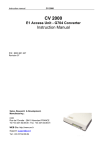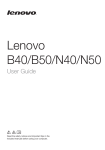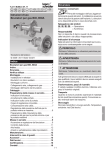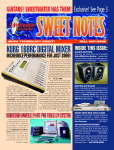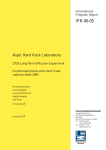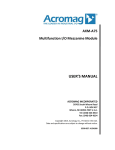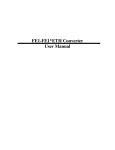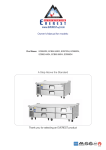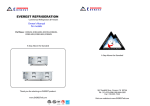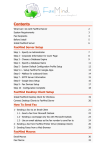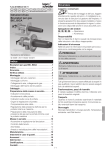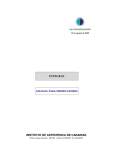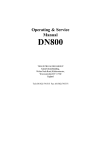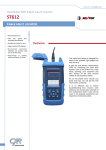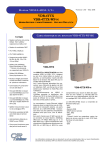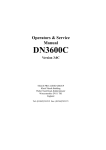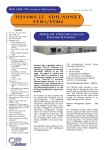Download FO 8000 Export
Transcript
Instruction manual FO 8000 FO 8000 Fibre Optic Modem Instruction Manual P/N : 8000 601 786 Revision 10 Sales, Research & Development, Manufacturing : CXR SA Rue de l'Ornette - 28410 Abondant FRANCE Tel +33 237.62.88.00 - Fax +33 237.62.88.01 WEB Site: http://www.cxr.fr Support: [email protected] Tel: +33 237.62.88.04 Instruction Manual FO 8000 Warning : No part of this document should be reproduced transmitted or translated without written authorization from CXR S.A All rights reserved. Copyright 2005, CXR SA, Printed in France, 2006 May. The only purpose of this manual is to provide information and installation instructions CXR reserves the rights to improve its products and specifications without notice. CXR has made every effort to provide the best possible quality in writing this manual but cannot be held responsible for any damage, which could result from errors or improper description of the equipment, its characteristics and operation. Please read and enforce the safety instructions of the safety and installation chapters. The team at CXR Anderson Jacobson thanks you for choosing the FO8000 Fibre Optical Modem We hope that this equipment will provide full satisfaction and in order to serve you even better, we thank you for returning the warranty card you will find at the end of this manual. We also invite you to read the last part of this manual, which provides useful information on the warranty terms and conditions, which apply to your equipment. FO 8000 - Page 2 Instruction Manual FO 8000 Content 1. INTRODUCTION .................................................................................9 1.1. 1.2. 1.3. 2. FIBRE OPTIC LINK...........................................................................10 2.1. 2.2. 2.3. 2.4. 2.5. 3. LAN TO LAN CONNECTION .............................................................16 LAN TO LAN CONNECTION VIA FIBRE AND E1/E1 NETWORK ............16 LAN TO LAN BRIDGING ..................................................................16 V28 ASYNCHRONOUS OR SYNCHRONOUS INTERCONNECTION ...........17 E2, E1 OR 4E1 PBX, DATA INTERCONNECTION ..............................17 TERMINAL ADAPTER TO PBX TRANSPORT .......................................18 CLOCK MODE.................................................................................18 OPERATION AND CONFIGURATION............................................20 5.1. 5.2. 5.3. 5.3.1. 5.3.2. 5.3.3. 5.3.4. 5.3.5. 5.3.6. 5.4. 6. LED DISPLAY .................................................................................14 THE PUSH BUTTON .........................................................................15 TYPICAL APPLICATIONS ...............................................................16 4.1. 4.2. 4.3. 4.4. 4.5. 4.6. 4.7. 5. MULTI-MODE FIBRE ........................................................................10 SINGLE-MODE FIBRE ......................................................................10 CALCULATION OF THE BUDGET AND FIBRE DISTANCE .......................11 DESKTOP VERSION .........................................................................11 RACK MOUNT VERSION ...................................................................12 FRONT PANEL, DISPLAY ...............................................................14 3.1. 3.2. 4. DTE INTERFACE ..............................................................................9 CONDITIONING ...............................................................................10 CONFIGURATION ............................................................................10 CONFIGURATION SOFTWARE MXCFG ..............................................20 FACTORY AND USER CONFIGURATIONS ...........................................21 VT100 INTERACTIVE MENUS .......................................................... 21 Menu 1 : Configuration ................................................................................................ 23 Menu 1.2 : Edit a configuration (except FO8011 option 96 and FO80E2).................... 24 Menu 1.2 FO8011-96, FO80E2: Edit a configuration ................................................... 26 Menu 2 : Status and statistics ...................................................................................... 27 Menu 3 : Loop Test...................................................................................................... 27 Menu 4 : Display and passwords ................................................................................. 28 REMOTE CONTROL .........................................................................28 DIAGNOSTICS AND TESTS ............................................................29 6.1. 6.2. 6.2.1. 6.2.2. DIAGNOSTICS .................................................................................29 TEST ............................................................................................. 30 Local Analog Loop ....................................................................................................... 30 Remote Digital Loop .................................................................................................... 31 FO 8000 - Page 3 Instruction Manual FO 8000 7. MEMORY...........................................................................................32 8. TECHNICAL CHARACTERISTICS ..................................................33 8.1. 8.2. 9. TRANSMISSION MODES ...................................................................33 GENERAL CHARACTERISTICS ..........................................................34 TROUBLESHOOTING ......................................................................35 9.1. 10. POWER UP .....................................................................................35 APPENDIX......................................................................................36 10.1. 10.1.1. 10.1.2. 10.1.3. 10.1.4. 10.1.5. 10.1.6. 10.2. 10.2.1. 10.2.2. 10.3. APPENDIX A – WIRING ................................................................ 36 Serial Control Port - RJ45........................................................................................ 36 RJ45 - Line connector.............................................................................................. 36 10 Base T Interface connector................................................................................. 37 X21/V11 and V35 Interfaces connector & wiring..................................................... 38 X21/V11 Option 96 Interfaces connector & wiring ................................................... 39 BRI Interface RJ45 ............................................................................................... 40 APPENDIX B - JUMPERS CONFIGURATION ..................................... 41 DIP SWITCH position on daughter card FO8xBR................................................... 41 DIP SWITCH position on daughter card FO80E2 ................................................... 43 APPENDIX C : WARRANTY, GENERAL CONDITIONS......................44 FO 8000 - Page 4 Instruction Manual FO 8000 Convention, range of product and options Several versions of the unit differ from the following characteristics: The type of Terminal interface: V28, V11, V35, 10BT, HUB, E1, 4E1, 4BRI, 2BRI, E2 The type of power supply: 110 / 230 Vac internal or external, 48 Vdc, 5Vdc external The type of packaging: stand alone enclosure or rack mountable card The type of optical Fibre: Multimode 820 (1300 nm option), Single mode 1310 and 1550 nm connector ST ( SC, FC in option ) These different versions are summarized on the following table. The same designations will be used throughout this manual to identify the differences between versions when applicable. Rack mountable card Desktop Version Interface FO 8011-mmcz X21-V11 FO 8011-mmcz-96 X21-V11 transparent mode FO 8035-mmcz V35 FO 80BT-mmcz 10 BaseT filtering bridge FO 80HB-mmcz Hub 4 ports FO 80E1-mmcz E1 / G704 FO 84E1-mmcz 4 * E1 / G704 FO 82BR-mmcz 2 * BRI FO 84BR-mmcz 4 * BRI FO 8028-mmcz V28 / RS232 FO 80E2-mmcz E2 / G703 FO 8000 - Page 5 The variants mmcz are: Variant Multimode 820 nm Multimode 1300 nm (option) Single mode Led 1310 nm (ST connector only) Single mode Laser 1310 nm Single mode Laser 1550 nm Connector SC (option) Connector ST® Connector FC (option) External power supply 5 Vdc Internal power supply 90 – 240 Vac Internal 48 Vdc converter Rack mount card AMS16 MM M8 M3 SL Z3 Z5 C Z C T F V I C R ST® is a registered trademark of AT&T Default connector is ST . ( SC and FC in option ) Example: The FO 8011 M3CI-E is a desktop version with internal 110 / 230 Vac power supply that provides an X21-V11 DTE interface DTE, fibre optic is Multimode at 1300 nm with SC connector in Export version. X21-V11 and V35 cables are available as an option: • V35: CXR reference CA.601.460 • X21-V11 (DB15): CXR reference CA.601.461 Important Information Conformity Statement EC Manufacturer name: CXR Manufacturer address: rue de l'Ornette - 28410 ABONDANT - France States that: Product name: FO 8000 Complies with the following specifications: Safety: EN 60950 EMC: EN 55022: - Class B EN 50082-1 The CE marking on this product indicates that it complies with 99/5/CE order dated April 7-1999 FO 8000 - Page 6 Instruction manual FO 8000 Safety Instructions The following accesses are referenced as SELV (Safety Low Voltage] in conformity with EN.41003 standards: • • • • • • • • • • 5 VDC Input of the FO 8000 desktop unit 48 VDC Input of the FO 8000 desktop unit Control: V24 - RS232 configuration port DTE - V11: V11-X21 interface of the FO 8011 unit DTE - V28 : V28 interface of the FO8028 DTE - V35 : V35 interface of the FO8035 DTE - 10BT : Ethernet interface of the FO80BT DTE - HUB : 4 port HUB Ethernet interface of the FO80HB DTE - E1 : E1 G 704 interface of the FO80E1 DTE - 4E1 : four E1 G 704 interfaces of the FO84E1 • • DTE - BRI: 2 or 4 ISDN S interface of the FO 82BR or FO 84BR unit DTE – E2 : E2 G 703 interface of the FO80E2 Desktop FO 8000 V: The wall mount power supply adapter is the main switching element. Thus this plug must be installed close to the equipment and provided easy access. To totally disconnect the equipment from the supply source we recommend you disconnect the power cord from the mains wall outlet. In order to comply with the safety regulations, it is imperative to use the accessories (power supply and cables) provided with the equipment. When access to the inside of the modem is necessary, it is imperative to disconnect the power adapter from the mains outlet. Desktop FO 8000 I : The power cord is the main switching element. Thus the mains outlet must be installed close to the equipment and provided easy access. In order to comply with the safety regulations, it is imperative to use the accessories (power supply and cables) provided with the equipment. When access to the inside of the modem is necessary, it is imperative to disconnect the power cord from the mains outlet. This is a Class 2 product as shows the symbol close to the mains socket; its earth connection is for functional purpose only. Rack mountable card FO 8000 R: The power switch located on the rear of the chassis is the only switching element, thus it must be fully accessible. The connection to the mains is achieved through the cable equipped with a malegrounded plug. Extract the card from the chassis when maintenance or servicing is required For safety reasons, any operation on the equipment and particularly opening the desktop enclosure must be carried out by maintenance person qualified by CXR. The equipment must imperatively be returned to CXR in any case of anomaly, fall, loss of performance, water exposure, power supply damage, … Optical Fibre: Class 1 Product WARNING: Do not look directly into the aperture of the transmitting diode or the optical fibre. The light beam which is emitted could cause permanent damage to your eyes. FO 8000 - Page 7 Environment The FO 8000 is designed for residential or light industrial use within the following environmental conditions: • • • • • • • Storage Temperature 0 to 70 °C Operating Temperature: 0 to 45 °C Hygrometry: 0 to 90% without condensation Class: IP40 Flammability: UL94-V0 Equipment must not be exposed to excessive solar radiation Equipment must not be in contact with water. It must not be used near a water reserve or in a wet location. Use The FO 8000 is designed to be connected to a DTE G703/G704 compatible network or to a to an X21-V11 or V35 or V28 or to an Ethernet 10BT equipment. • Nx64 KBPS DTE interface : from 64 KBPS to 2048 KBPS • X21 and V35 DTE interface : from 64 kBps to 2048 kBps by step of 64k and 4096, 6144, 8192 kBps • X21-V11 option 96: Transparent mode from DC to 8448 MBPS External clock from DTE. Both FO8011 are co directional. External clock from DTE and Network clock to remote. Not codirectional, only one clock source. • V28 – RS232 interface : asynchronous up to 115200 Bps synchronous up to 128000 Bps • Ethernet bridge and 4 port Hub : Ethernet 802.3 Frame buffer : 256 Mac address memory : 10.000 • Interface E1 and 4E1 G703-G704: rate G703: 2048 Kbps +/- 50ppm coding: HDB3 framing: 32 Time Slots - G704 compatible receiver sensitivity: -40 dB • Interface E2 G703: rate G703: 8448 +/- 20 ppm ( also operational at 2048 Kbps +/- 50ppm ) coding: HDB3 receiver sensitivity: -10 dB Short Haul • BRI interface: 2 or 4 ISDN S interface Network or Terminal interface FO 8000 - Page 8 Instruction manual FO 8000 Fibre Optic Link : Multimode 62.5/125µm 820 nm: budget 15 dB i.e. 4 kms @ 3dB/kms Multimode 62.5/125 µm 1300 nm : budget 12 dB i.e. 8 kms @ 1.5dB/kms (option) Single mode 9/125 µm 1310 nm Led : budget 14 dB i.e. 40 kms @ 0.35 dB/kms Single mode 9/125 µm 1310 nm Laser : budget 23 dB i.e. 65 kms @ 0.35 dB/kms Single mode 9/125 µm 1550 nm Laser : budget 29 dB i.e. 120 kms @ 0.23 dB/kms Correct Disposal of the Product - Recycling In compliance with the European rules for separate collection systems and Waste of Electric and Electronic Equipment, this marking shown on this product indicates that it should not be disposed with other household wastes at the end of working life. To prevent possible harm to the environment or human health from uncontrolled waste disposal, please separate this from other types of wastes an d recycle it responsibly to promote the sustainable reuse of material resources. Household users should contact either the retailer were they purchased this product, or their local government office for details of where and how they can take this item for environmental safe recycling. Business users should contact their supplier and check the term and conditions of the purchase contract. This product should not be mixed with other commercial wastes for disposal. 1. Introduction The FO 8000 is a fibre optic modem with different DTE interface X21/V11, V35, V28, 10 BaseT, E1, 4E1 (2048 KBPS), E1 (8448 KBPS) or 2BRI or 4BRI (2 or 4*192 KBPS) network access. 1.1. DTE Interface The FO 8000 can be equipped with different types of interface: X21/V11 or V35 interface: for synchronous data transmission at speed of up to 8192 KBPS. Clock can be configured as internal, external or slaved. Most interface signals can be forced or activated when the connection is established. X21/V11 option 96: for synchronous data transmission at speed of up to 8448 KBPS. When clock is in external mode and both local and remote FO are codirectional, the clock value must be very different, like 4096 kbps in upstream and 175 kbps in downstream. Most interface signals can be forced or activated when the connection is established. When clock is not codirectional, one FO8011 must be in external mode (DTE) and the remote must be in network clock mode. V28 interface: for synchronous data transmission at speed up to 128000 Bps, for asynchronous data up to 115200 Bps. In synchronous mode clock can be configured as internal, external, or slaved. Most interface signals can be forced or activated when the connection is established. 10BT interface and HUB 4 ports: The built-in Ethernet bridge filters the frames in accordance with their destination MAC address. Only frames with non-local MAC addresses are transmitted to the remote unit. The bridge can memorize up to 10.000 local addresses and process 15.000 frames per second. E1 Interface: for E1 G703 or G704 network access at 2048 kBps. Clock can be configured as internal, external or slaved. 4E1 Interface: for four E1 G703 or G704 network access at 2048 kBps. Clock can be configured as internal, slaved or external ( 1 of 4 DTE port ). BRI interface: to transport 2 or 4 ISDN S interfaces. FO 8000 - Page 9 E2 Interface: for E2 G703 at 8448 KBPS ( or E1 G703 2048 KBPS ). Clock is always in external mode. The local and remote FO80E2 are co directional, the clock value must be different. 1.2. Conditioning The FO 8000 can meet all integration requirements either as a desktop or rack-mount unit with different power-supply configurations External power bloc: provides a regulated 5 VDC from the mains 110/230 VAC Internal power supply: the modem includes a 110/230 VAC - 5 VDC power converter which connects directly to the mains outlet via the supplied power cord Internal 48 VDC converter: the modem includes a 48 VDC power converter, which can be connected to a 48Vdc supply commonly available in telecom centers. Rack-mountable card: the 5 VDC required by the modem is supplied by the rack in which the card is inserted. The AMS 4 and AMS 16 chassis can be powered from 110/230 VAC or 48 VDC depending on the type of power module installed with provision for full redundancy 1.3. Configuration The FO 8000 is configured via the serial control port set for VT100 emulation at 19200 BPS with data format of 8 bits, parity none. The configuration is menu driven with on line help facilities. Only a few keyboard strokes will be required to set and save the FO 8000 parameters. These menus also initiate analog and digital test loops and display a status report and a bit error rate statistics. Alternatively the modem can be configured using an AT command set which provides access to all modem parameters. The FO 8000 card can also be configured by the CFIP controller card of the AMS16 chassis though its local VT100 mode or TCP-IP Telnet and SNMP management protocols 2. FIBRE OPTIC link The FO 8000 supports two different fibre optic type : multi-mode or single mode fibre. 2.1. Multi-mode Fibre This is the classic fibre optic cabling, the most commonly installed core is 62.5 micrometers and outer cladding size is 125 micrometers. The FO 8000 component are compatible with 62.5 and 50 micrometers core. In multi-mode fibre, the FO 8000 uses two different wavelengths the 820 nanometer and 1300 nanometer. These wavelengths allow distance up to 8 kms between two FO8000. In multi-mode fibre at 820 nanometer, the modal dispersion is not negligible, but the limit is greater than the fibre attenuation. The attenuation of the beam is more important in the 820 nanometer than in the 1300 nanometer. All the calculation of the budget and fibre distance are described in the next paragraph. Typically the multi-mode fibre is orange. 2.2. Single-mode Fibre Single-mode fibre uses a smaller core diameter of 9 micrometer and the cladding size is also 125 micrometer. FO 8000 - Page 10 Instruction manual FO 8000 In single-mode fibre the FO 8000 supports also two different wavelength component, the first is 1310 nanometer and the second is 1550 nanometer. The attenuation is close to the theoretical attenuation at 1550 nanometer. Typically the single-mode fibre is yellow. 2.3. Calculation of the Budget and Fibre Distance The F8000 is defined by the DTE Interface and the Fibre Optic Budget at the different wavelength. The Fibre Budget is the difference between the receiver sensivity and the transmitter power. On each wavelength, a fibre attenuation per kilometer is defined. Between the two FO 8000 there are some connectors and splices. The connector attenuation is 1 dB, and splice attenuation is 0.05 dB. A buffer is added into the calculation ( 2 dB ). Distance = (Fibre Budget) – (Splice Loss) – (Connector Loss) – Buffer (Fibre Attenuation) Example: In multimode fibre at 820 nm the attenuation is 3dBm/km, with two connectors (2 dB) and one splice (0.05 dB), the Fibre Budget of FO 8000-M8 is 15 dB. Distance = 15 – 0.05 – 2 – 2 = 3.6 km (with margin) 3 Example: In monomode 1310 nm attenuation is 0.3 dBm/km and the FO 8000-SL budget is 23 dB Distance = 14 - 0.05 – 2 – 2 = 33 km 0.3 This calculation is realized with the above values, but the actual loss in the fibre is better measured once the fibre is installed, generally it is impossible to know the number of connectors and splices. 2.4. Desktop version Accessories • • • • • One RJ45-RJ 45 cable and one RJ45-DB9 converter (P/N: 7055031517) for the control port External power supply module when applicable . One DB25-DB15 cable as an option of the X21-V11 interface FO8011 version (P/N:CA601461). One DB25-V35 cable as an option of the V35 interface FO 8035 (P/N:CA601460). This user Manual Connection • • • • Connect the modem as per the following drawing. View is from the rear. Ensure that the end face of the optical plugs are clean. Connect the fibre optic ( type ST, SC, FC ) : ensure that the optical input Rx and output Tx are connected to the other unit ( crossover connection ). The DTE terminal connector depends on the type of interface: o A DB25 socket for V28-RS232, X21-V11 and V35 interfaces, FO 8000 - Page 11 o o o o o An RJ45 socket for 10BT, E1, E2. Two BNC for E2 and E1 interface in option (Transmitter near the fibre, Receiver near the power connector) Four RJ45 socket for 4E1 interface. Four RJ45 for the HUB interface. Four RJ45 for the 2BRI or 4BRI interface. Rear panel CONTROL FO TX RX TERMINAL OFF ON DTE interface SELV 110/230V Control V24.RS232 SELV Another FO8000 RX<->TX crossed TX<->RX crossed (*) 110/230VAC / 5VDC Wallmount power supply or 110/230VAC or 48 Vdc cable as applicable. (*) SELV = Safety low voltage • For safety reasons it is imperative to use the accessories (power unit and cable) provided with the equipment. Powering The mains adapter / cord is the only switching device and therefore the mains outlet should be located close to the equipment and easily accessed Once the FO 8000 has been connected, switch the ON-OFF switch to the « ON » position. 2.5. Rack mount version Accessories • • • • One RJ45-RJ 45 cable and one RJ45-dB9 converter for the control port One DB25-DB15 cable as an option of the X21-V11 interface –FO 8011 version (P/N: CA 601 461) One DB25-V35 cable as an option of the V35 interface –FO 8035 (P/N:CA 601 460) This user Manual Installation • • Please also refer to the chassis user manual for the modem installation. Locate a free slot in the chassis and insert the FO 8000 card. Connection FO 8000 - Page 12 Instruction manual • • • • FO 8000 Connect the FO 8000 at the rear of the chassis as per the following drawing. Ensure that the end face of the optical plugs are free of contamination. Connect the fibre optic ( type ST, SC, FC ) : ensure that one optical input Rx and one optical output Tx are connected to one another ( crossover connection ). The DTE terminal connector depends on the type of interface: o A DB25 socket for V28-RS232, X21-V11 and V35 interfaces, o An RJ45 socket for 10BT, E1, T1. o Two BNC for E1 in option, or E2 interface. o Four RJ45 for 4E1 interface. o Four RJ45 for the HUB interface. o Four RJ45 for the 2BRI or 4BRI interface. DTE SELV OpticalFiber RX Optical Fiber TX Control V24-RS232 SELV FO 8000 - Page 13 Powering • • The modem card connects to the chassis power supply when it is fully inserted. The chassis is powered on and off through the rear panel mains switch. Screw the unit front panel on the chassis to avoid any accidental power or connection loss 3. Front Panel, Display This chapter describes the operation of the 6 LED indicators and the push button. 3.1. LED display Six LED indicators and one pushbutton are installed on the front panel of the Desktop and rack mount unit. The LEDs display an indication on the status of the FO8000. POWER LED DTE SYNC ERR DATA TEST CLR Function / POWER ON when the unit is powered BLINKING when the unit is powered and the control and configuration terminal is connected and provides an active DTR-108 signal to the control port Shows that the terminal equipment is connected. C Signal for V11 DTE interface, DTR signal for V28 and V35, E1 carrier for E1, E2 carrier for E2 card, link for 10BT and HUB, 4 carriers E1 simultaneous on each second for 4 E1 card, 4 synchronized access simultaneous on each second for 4 BRI card FO 8000 - Page 14 Instruction manual LED SYNC ERR DATA TEST 3.2. FO 8000 Function ON when the optical link is synchronized. BLINKING is case of loss of synchronization. OFF when optical link is not synchronized. ON (red) in case of error. (like CRC error or HDB3/B8ZS/AMI code violation in E1 DTE) This LED is cleared by the push button (CLR) or by VT100 interface. AIS detection for E2 card. Blinking when data are sent or received on the DTE interface. ON (yellow) when the FO 8000 is in test mode. The push button When pushed at power up, it forces the FO 8000 to enter in firmware download mode (Flash loader). The Power, DTE and TEST LED stay ON in this state. FO 8000 - Page 15 4. Typical applications This chapter describes the basic configuration of the FO 8000 in some typical applications. 4.1. LAN to LAN connection Two corporate LAN are connected together throw fibre optic link. FO8011 FO8035 FO8011 FO8035 …… X21 or V35 …… X21 or V35 Fibre Optic 820,1300 nm Multimode 1310, 1550 nm Singlemode 4.2. LAN to LAN connection via Fibre and E1/E1 network Two corporate LAN are connected together through a fibre optic link and an E1 or T1 network access . The payload may be lower than 2048 KBPS (E1) or 1544 (T1) and provide lower network access cost (fractional E1 / fractional T1). FO8011 FO8035 X21 or V35 FO80E1 …… …… FO8035 …… E1/T1 Network X21 or V35 Fibre Optic 820,1300 nm Multimode 1310, 1550 nm Singlemode 4.3. LAN to LAN bridging Two FO 80BT provide an efficient bridging of two Ethernet networks and spare the use of routers of the previous connection scheme. 10BaseT 10BaseT …… …… FO80BT FO80BT Fibre Optic 820,1300 nm Multimode 1310, 1550 nm Singlemode FO 8000 - Page 16 Instruction manual FO 8000 In case of problem or if the Ethernet frame do not comply with the IEEE 802.3 standard then the following AT parameters could be set on both FO 8000: *F0: disables the MAC address filtering *P0: disables the Padding bit deletion These parameters are modifiable in the menu VT100. 4.4. V28 asynchronous or synchronous interconnection To control remotely a serial unit. RS232 RS232 RS232 Unit …… …… FO8028 FO8028 Fibre Optic 820,1300 nm Multimode 1310, 1550 nm Singlemode 4.5. E2, E1 or 4E1 PBX, Data interconnection Interconnection of one or four E1 equipments with FO80E1 or FO84E1 modem. E1, E2 PBX …… …… FO80E1 FO84E1 FO80E2 Router E1 PBX FO80E1 FO84E1 FO80E2 Fibre Optic 820,1300 nm Multimode 1310, 1550 nm Singlemode Router E1 With a FO80E2 local, the remote modem can be another FO80E2 or an FO8011 in transparent mode. The release software must be identical. Speed at 8448 or 2048 KBPS. FO 8000 - Page 17 4.6. Terminal Adapter to PBX transport A pair of FO84BR can transport up to 4 ISDN Basic Accesses. For example four Terminal Adapters are connected to a remote PBX , through two FO 84BR over a Fibre Optic. The four B1+B2+D channels are transported. 2 Channels only for the FO82BR. ISDN-S Adapter 4 ISDN-S access Fiber Fiber …… …… ISDN phone FO84BR A 4 ISDN-S access FO84BR B PBX ISDN-S Adapter Timing Consideration • If PBX is connected to the public telephone network and gives the master source timing. The FO84VBR “B” uses this clock and must be in DTE clock mode, then it sends its clock to the fibre, and the FO84BR “A” must be in Network clock mode. For a new installation, it’s better to connect the FO84BR B near the PBX in firstly. 4.7. Clock Mode The fibre optical modem FO 8000 is used to carry data between two DTE interfaces. The FO 8000 also carries the clock in most cases. DTE A FO 8000 A Fibre Optic FO 8000 B DTE B A – The DTE A equipment provides the clock in internal mode, and gives it to the FO 8000 and other DTE B (router V35 / V11, E1/4E1 network, V28-RS232, 4BRI) . Type DTE A FO 8000 A FO 8000 B DTE B A DTE Clock Network Clock Receive clock Internal Clock FO 8000 - Page 18 Instruction manual FO 8000 B – Both equipments DTE A and DTE B receive the clock, the FO8000 A generates the clock for DTE A and transmits it to the other FO 8000 B and DTE B. (router V35/V11, network E1, V28-RS232, 10BaseT and HUB) Type DTE A FO 8000 A FO 8000 B DTE B B Internal Clock Network Clock Receive clock Receive clock C – Both equipments DTE A and B gives the clock to the FO 8000 A, B . FO8000 A and B are in external clock. (E1 and 4E1 with 2 PBX sometimes) Type DTE A FO 8000 A FO 8000 B DTE B B external Clock external Clock Internal clock Internal clock D – With FO84E1 all the DTE port clock must be isochronous. E – With FO8011-96 and FO80E2 when the mode is codirectional the clock must be in external clock mode. The local and the remote FO are co directional. The upstream can be different with the downstream. When the clock is not codirectional, one FO8011 must be in external, the other FO8011 must be in network clock. Se chapter 10.1.4 and 10.1.5 for signals and explications. FO 8000 - Page 19 5. Operation and Configuration This chapter describes the FO 8000 operation through its Control port. The FO 8000 must be connected to a VT100 compatible terminal or to a PC running a VT100 terminal emulation software that should be configured as follows: Speed: 19200 bps Data format: 8 bits Parity: none Stop bit: 1 Emulation: VT100 Flow control: none The FO 8000 configuration can be made either in AT command mode or VT100 Interactive menu mode. The choice of mode is automatic: the AT command mode is activated when an “AT” or ”at” character string is received from the control port. The VT100 menu mode is started when the modem detects three consecutive carriage returns or “ENTER” characters. The use of the VT100 mode offers valuable advantages such as simplicity and on line help. The use of the AT commands allows writing configuration programs which can be saved out of the unit on a PC for instance and can also be protected with a password. All the FO 8000 operation parameters can be modified and saved in either mode. The detail of the AT command is described in another document. ( Ref CXR : 8000 601 836 ) 5.1. Configuration Software MxCfg The configuration software Mxcfg allows: • See the current configuration of FO8000 • Modify the parameters • Save the new parameters • The all the parameters in a file on your Laptop • View the diags Mxcfg run under Windows 95/98/NT/2000/XP. To install Mxcfg, type “a:\Setup.exe” on the floppy disk or “\tools\french\mxcfg\setup.exe" on the CDROM. For more information, or in case of problem see the help file (Button Help or the F1 touch). FO 8000 - Page 20 Instruction manual 5.2. FO 8000 Factory and User Configurations The FO 8000 has 4 user definable configurations and one read-only factory configuration. The configuration process consists in setting up the FO 8000 parameters for the application and then saving these parameters in the user memory. The active configuration must then be defined; it is activated even after a power shut-off. Chapter 7 describes the various memories used by the unit. 5.3. VT100 Interactive Menus The FO 8000 sends the VT100 menu pages when it detects three consecutive <CR> or 'ENTER' characters. The possible choices are listed on the bottom line of the screen: 1 to 9 are valid options on the menu to start a sub-menu or to change a parameter value P or p: to return to the Previous menu Q or q: to Quit the VT100 menus and return to the AT command mode Acknowledge your choice by Enter (or CR) Some parameters should be selected in a revolving list which can be exited by the ‘#Abort operation#’ choice in any need of aborting the current selection. FO 8000 - Page 21 The arrow keys must be used in some menus. Some VT100 terminal emulation software may need some settings to allow the use of these keys (HyperTerminal,). The / * - + key may also be used in case of problem. LEFT: RIGHT: / * UP: - DOWN: + First menu : CXR - FO 8035 Main menu Configuration "cxr*" DTE=1984Kbps, CLK=INT 1) 2) 3) 4) 5) Configuration Status and statistics Loop test Display and passwords Remote -------------------------------------------------------------------------------Type your choice: 1 .. 4, Q(uit) and press RETURN -------------------------------------------------------------------------------FO8000 V1.06 - Dec 19 2001 - 0143CFD8 SN: 00009010 - 5001 The first menu provides access to the configuration, status and statistics displays and loop test sub-menus. The item ‘display and passwords’ access to a submenu for the choice of passwords, language (English or French) and display mode Press ‘Q’ to exit the VT100 menus and return to the AT command mode. FO 8000 - Page 22 Instruction manual 5.3.1. FO 8000 Menu 1 : Configuration CXR - FO 8035 Configuration menu Configuration "cxr*" DTE=1984Kbps, CLK=INT 1) 2) 3) 4) View a configuration Edit a configuration Activate a configuration Remove a user configuration -------------------------------------------------------------------------------Type your choice: 1 .. 4, P(revious) and press RETURN -------------------------------------------------------------------------------- 1. View a configuration: the arrows select the configuration to view, either the current configuration (Active), or the factory configuration (Factory), or one of the user defined configuration ([user n]). 2. Edit a configuration: the arrows select the model of configuration to use. Parameters are edited in a memory dedicated to editing: this memory could be then saved into a user memory, eventually the model one. 3. Activate a configuration: the arrows select the configuration that will be active when the unit will restart. It could be the factory or any user defined configuration. Warning: this option restarts the FO8000. The active configuration is spotted by an asterisk ‘*’. This operation must be confirm or aborted by a choice Yes / No. 4. Remove a user configuration: This option is displayed only if user defined configurations are stored in memory. The arrows select the configuration to be removed. The factory configuration becomes the active configuration at the next restart of the unit if the active configuration is removed. This operation must be confirm or aborted by a choice Yes / No. 5. Save configuration: this option is displayed after a configuration has been edited. The arrows select the user-defined memory where the edited configuration will be stored. This may overwrite an existing configuration, or define an empty configuration. In this case a name can be given to the configuration. This operation must be confirm or aborted by a choice Yes / No. Warning: the configuration does not become active when it is saved – see the previous option (3) FO 8000 - Page 23 5.3.2. Menu 1.2 : Edit a configuration (except FO8011 option 96 and FO80E2) CXR - FO 8035 Configuration menu Configuration "cxr*" DTE=1984Kbps, CLK=INT +------------------------------------------------------------------------------+ | Baud rate : 1984Kbps | | Fraction. E1 : DISABLE | +------------------------+-----------------------------------------------------+ | Clock source : INTERN | Specific parameter for V35 interface | +------------------------+ | | Inverted clck: ENABLE | DSR control : Forced | +------------------------+ CD control : =CD | | RDL : REFUSE | CTS control : Forced | +------------------------+--------------------------------- Previous Menu -----+ Move the cursor on the value to modify with the arrows, then validate, next modify the value with the arrows, validate the new chose. To leave this screen , go to the Previous Menu and validate. Here are all the parameters associated with all interfaces except with the F8011-96. Baud Rate : • Interface V35 and V11/X21 from 64 kbits/s to 2048 kbps by step of 64k and 4096, 6144, 8192 kbps. • interface V28 synchronous from 1,2 kbps to 128 kbps. • interface 10BaseT and Hub from 64k to 9344 kbps ( chose the upper speed for higher performance, or chose a speed in accordance with the other modem in Fractional E1 or T1 ). • Interface E1 or 4E1 at 2048 kbps. • Interface V28 Asynchronous ( transparent up to 115,2 kbps ). • Interface 4BRI 4 * 192 kbps (fixed) Clock source : • Internal clock : the transmission to the network is synchronized by the internal clock (based on a crystal oscillator in interface X21, V35, 10baseT, HUB, V28 synchronous, E1. • External clock : clock is provided by the DTE and is sent to the remote unit. Apply on X21, V35, synchronous V28, E1 interface, 4E1, 4BRI interface (DTE1, DTE2, DTE3, DTE4 clock possibility ) • Network clock : the transmission to the network is synchronized by the clock recovered from the network receive path. (default value). In interface X21, V35, 10BaseT, HUB, V28, E1, 4BRI, 4E1. Inverted clock : FO 8000 - Page 24 Instruction manual • FO 8000 Data are generated on the falling edge of the clock for the X21, V35 and V28 interfaces (default behavior). However it’s possible to select the rising edge of the clock. RDL : • Remote Digital Loop. This command enables or disables answer to RDL requested by the remote FO 8000 . Disable by default. DSR Control: • This parameter controls the activation of the DSR - 107 signal of the V35 or V28 interface. ( forced: always active, follows the 108 / DTR signal of the interface, active when the FO8000 is synchronized on the fibre optic ). CTS control : • This parameter controls the activation of the CTS - 106 signal of the V35 or V28 interface. ( forced: always active, follows the 105 / RTS signal of the interface, active when the FO8000 is synchronized on the fibre optic ). CD control : • This parameter controls the activation of the CD - 109 signal of the V35 or V28 interface. ( forced: always active, active when the FO8000 is synchronized on the fibre optic ). I control : • This parameter controls the activation of the I - 106 signal of the X21 interface. ( forced: always active, follows the C signal of the interface, active when the FO8000 is synchronized on the fibre optic ). Ethernet Address Filtering: • 10BaseT and HUB interfaces : this parameter enables or disables the frame filtering of the Ethernet local addresses. Default value is filtering. Padding Comp : • 10BaseT and HUB interfaces : this parameter enables or disables the discarding of Ethernet padding bits for the transmission between the FO 80BT. Padding bits are regenerated at the other side. Default value is on. Sensitivity : • E1, 4E1 and T1 interfaces : This parameter defines the network interface receiver sensitivity. It allows to select low sensitivity on short haul (-12dB for E1 or -30dB for T1) or an high sensitivity on(long haul ( -43dB for E1 or -36 dB for T1). Default is Short Haul. Bit E : • E1, 4E1 interface : this parameter defines the G704 E bit activation on CRC error detection. Used only when unframed isn’t validated. CRC : • E1, 4E1 interface : This parameter defines the G704 CRC4 (E1) or CRC6 (T1) i.e. ESF mode management. Used only when unframed isn’t validated. FO 8000 - Page 25 Unframed : • Interface E1, 4E1 : No (31 TS) – Framed mode (G704) • Interface E1, 4E1 : Yes (32 TS) – Unframed mode (G703 / 2048 kBps) Fractional E1 / T1 : • Interface V11, V35, 10BaseT, HUB only (not E1 or T1) . Timeslots can be extracted from a remote E1 / T1 FO unit to a V35, X21 or 10BaseT Interface. CXR - FO 80BT Configuration menu Configuration "o*" DTE=768Kbps, CLK=INT +------------------------------------------------------------------------------+ | Baud rate : 768Kbps | | Fraction. E1 : ENABLE +-+-+-+-+-+-+-+-+-+-+-+-+-+-+-+-+-+-+-+-+-+-+ | | +----------+-+-+-+-+-+-+-+-+-+-+1|1|1|1|1|1|1|1|1|1|2|2|2|2|2|2|2|2|2|2|3|3| | | | |0|1|2|3|4|5|6|7|8|9|0|1|2|3|4|5|6|7|8|9|0|1|2|3|4|5|6|7|8|9|0|1| | | +----------+-+-+-+-+-+-+-+-+-+-+-+-+-+-+-+-+-+-+-+-+-+-+-+-+-+-+-+-+-+-+-+-+ | | |DTE | |X|X|X| |X| | | | |X| |X| | | | |X|X|X|X|X| | | | | | | | | | | | | +----------+-+-+-+-+-+-+-+-+-+-+-+-+-+-+-+-+-+-+-+-+-+-+-+-+-+-+-+-+-+-+-+-+ | | | | | | | | | +------------------------+-----------------------------------------------------+ | Clock source : INTERN | Specific parameter for BRIDGE interface | +------------------------+ | | | Ether.Filter : ON | +------------------------+ Padding comp.: ON | | RDL : REFUSE | | +------------------------+---------------------------------Previous Menu------- Use left and right arrows (or / *) to place on the different Time Slot and arrows Up and Down (or - + ) to change the selected line. Then return to the previous Menu and save the new configuration. Mode BRI : this parameter activates interfaces in Terminal mode (TE, LT-T) or Network mode (NT, LT-S) • Terminal : connected to the PBX (DTE clock mode ) • Network : connected to the adapters or ISDN phones. (default value ). Network clock mode) 5.3.3. Menu 1.2 FO8011-96, FO80E2: Edit a configuration With this release only 5 parameters are used: • Inverted clock: Data are generated on the falling edge of the clock for the X21 interfaces (default Disable). Rising edge of the clock (Enable). • RDL : Refused or Accepted. • I signal Indication: =C (local signal Control), =CD (fibre optic carrier), =Remote C (remote FO8011 Control signal ), Forced (always ON) • Clock source : External DTE1, or Network • Codirectional: Yes or No: FO 8000 - Page 26 Instruction manual FO 8000 o If Yes: clock source must be in external clock mode. External clock and data are transmitted through the fibre optic and the remote FO8000 send Receive clock and data. The pulsation between the receive and transmit in the fibre optic can be different. o If No: one F08011 is in external clock mode and the remote FO8011 is in network clock mode. External clock and data are transmitted through the fibre optic and the remote FO8011 send clock and data, the remote product send the data with the FO8011 clock, in local the FO8011 send the data with the external clock. The local FO8011 introduce a FIFO to synchronize the receive data with the external clock (see chapter 10.1.5 for details). CXR - FO 8011 Configuration menu Configuration "o*" DTE=Transparent, CLK=NWK 1) 2) 3) 4) 5) 5.3.4. Inverted clock: RDL : I Signal : Clock source : Codirectional : DISABLE REFUSE =REMOTE C NET NO Menu 2 : Status and statistics The FO 8000 displays its operating parameters and connection statistics for evaluation of the transmission quality. See chapter 6 for more information. 5.3.5. Menu 3 : Loop Test CXR - FO 80E1 Test & loop menu Configuration "ooo*" DTE=2048Kbps, CLK=NWK, CRC=OFF, BIT E=OFF 1) Start local loopback 2) Start remote loopback 3) Start local digital loopback This menu allows loop test activation: • • • Local analog loop Remote digital loop: request a loop to the remote FO 8000 Local digital loop See chapter Test in 6.2 for more details. FO 8000 - Page 27 5.3.6. Menu 4 : Display and passwords CXR - FO 80E1 - cxr Display and passwords Configuration "ooo*" DTE=2048Kbps, CLK=NWK, CRC=OFF, BIT E=OFF 1) 2) 3) 4) 5) 5) 6) Language : English Graphic char set : disabled Led Mode : On TX&RX Auto-logout time limit : 15 Site name: cxr Maintenance password System manager password -------------------------------------------------------------------------------Type your choice: 1 .. 6, P(revious) and press RETURN -------------------------------------------------------------------------------- This menu allows to change user interface parameters: the language of the menus, the use of the graphic character set allowed by some VT100 emulators, the front panel Data LED mode, the inactivity time out (in minutes) on the control port (after this time the user is logged out), the passwords: the system manager level permits all functions and the maintenance level allows only to view configurations and status & statistics. 5.4. Remote control The remote B unit can be control from the main configuration menu of the A unit. With The ATO command, the A modem take the control of the B modem and displays the screen of the remote modem F08000 B. The ATH command ends this remote control session. All remote control data are passed in an out band channel which does not slow or disturb the application data flow. With the menu 5, it’s possible to take the remote control too. FO8000 A fibre optic …… Control Port A FO 8000 - Page 28 FO8000 B …… Instruction manual FO 8000 6. Diagnostics and tests 6.1. Diagnostics CXR - FO 80E1 : Status & Statistics Configuration "ooo*" : DTE=2048Kbps, CRC=OFF, CLK=NWK +-------------------------+--------------------------+-------------------------+ | Fibre carrier : ON | Uptime 0 d 00:30:14 | DTE detected : OFF | +-------------------------+--------------------------+-------------------------+ | Status (E1) Carrier : OFF Sync : ON | | CRC Sync : ON Remote Alarm : OFF | +------------------------------------------------------------------------------+ | Statistics | | +------------+-------------+-----------+-----------+-----------+-----------+ | | |Sec. with | Last 24hrs | Prev. hour| Cur. hour | Prev. 15m | Cur. 15m | | | +------------+-------------+-----------+-----------+-----------+-----------+ | | |NO FO Carr. | 00:00:00 | 00:00 | 00:00 | 00:00 | 00:00 | | | |NO Carr. E1 | 00:00:00 | 00:00 | 30:13 | 30:00 | 00:30 | | | |NO sync (E1)| 00:00:00 | 00:00 | 00:00 | 00:00 | 00:00 | | | | (nb errors)| (0) | (0) | (0) | (0) | (0) | | | |CRC Errors | 00:00:00 | 00:00 | 00:00 | 00:00 | 00:00 | | | | (nb errors)| (0) | (0) | (0) | (0) | (0) | | | |Code violat.| 00:00:00 | 00:00 | 00:01 | 00:00 | 00:00 | | | | (nb errors)| (0) | (0) | (19) | (0) | (0) | | | |E BIT | 00:00:00 | 00:00 | 00:00 | 00:00 | 00:00 | | | | (nb errors)| (0) | (0) | (0) | (0) | (0) | | | +------------+-------------+-----------+-----------+-----------+-----------+ | +-- Reset errors led ------ Reset statistics -------------- Previous Menu ----- In the top of the screen we find the type of interface, the speed, and clock mode. The status of the fibre link, the time since the power up, and the main information about the active configuration. The FO 8000 shows an error statistics picture displayed in duration of error or number of errors. Figures are provided for the last 24 hours, the previous hour and 15 minutes, and the current hour and 15 minutes, which show how the errors are distributed over time. The time without fibre carrier, without the DTE carrier. There are counters for E1/T1 coding violation, CRC errors, E bit active, and loss of Frame Alignment Signal (FAS). There are time counters for E1/T1 carrier status, G704 frame status, and terminal status based on the X21 C signal, or the V35 RTS signal, or the 10BT link integrity signal.. 4E1 Interface we see the four DTE port states: carrier, sync, crc, alarm. +-------------------------+--------------------------+-------------------------+ | Fiber carrier : ON | Uptime 0 d 01:31:02 | DTE detected : O.O. | +-------------------------+--------------------------+-------------------------+ | | Status(4E1) Carrier : ON CRC Sync : ON OFF ON OFF Sync : ON ON Remote Alarm : OFF OFF OFF OFF ON ON ON ON ON | | +------------------------------------------------------------------------------+ FO 8000 - Page 29 4BRI Interface: +-------------------------+--------------------------+-------------------------+ | Fiber carrier : ON | Uptime 1 d 01:17:10 | DTE detected : 00.. | +-------------------------+--------------------------+-------------------------+ | Status(4BR) | DTE 1: F7 Activat. DTE 2: F7 Activat. | DTE 3: F3 Deactiv. DTE 4: F3 Deactiv. | +------------------------------------------------------------------------------+ DTE1 to 4: reports the state of the BRI link integrity: activated or synchronized, deactivated, not initialised. FO8011-96 and FO80E2 Statistics: CXR - FO 8011 : Status & Statistics Configuration "o*" : DTE=Transparent, CLK=NWK +-------------------------+--------------------------+-------------------------+ | Fiber carrier : ON | Uptime 0 d 16:38:57 | DTE detected : ON | +-------------------------+--------------------------+-------------------------+ | Status(V11) | | C = ON I = OFF (=Remote C) remote C = OFF | +------------------------------------------------------------------------------+ | Statistics Frequence TCLK: 7679886 Hz - RCLK: 7679885 Hz | +------------+-------------+-----------+-----------+-----------+-----------+ | | |Sec. with | Last 24hrs | Prev. hour| Cur. hour | Prev. 15m | Cur. 15m | | | +------------+-------------+-----------+-----------+-----------+-----------+ | | |NO FO Carr. | 00:00:00 | 00:00 | 00:00 | 00:00 | 00:00 | | | |NO Signal C | 00:00:00 | 00:00 | 00:00 | 00:00 | 00:00 | | | +------------+-------------+-----------+-----------+-----------+-----------+ | +- Reset errors led ---- Reset statistics ------- Alarms ---- Previous Menu ---+ with this software release, the external and receive clocks are measured to indicate an approximate value a the frequency between the two senses. With FO80E2 Statistics are No signal Fibre Optic, No E2 synchronization, and AIS detected. 6.2. Test 6.2.1. Local Analog Loop The FO 8000 synchronizes to the carrier that it transmits on its line interface. This configuration provides a test of all the internal parts in the unit. This loop corresponds to an ITU-T V54 B3 loop.. DTE A FO8000 A …… Procedure : This loop is activated In the third menu of the VT100 interface, By the AT&T1 command The loop is acknowledged by the TEST Led on the front panel. FO 8000 - Page 30 Instruction manual 6.2.2. FO 8000 Remote Digital Loop The remote FO 8000 (B) sends back data received from the line which lets the terminal equipment (DTE A) test the data link up to the remote terminal point (DTE B). This loop corresponds to an ITU-T V54-B2 loop. DTE A FO8000 A …… FO8000 B DTE B …… Procedure : From location A, if the answer it RDL request is enabled on the FO8000 of side B In the menu 3 of the VT100 interface, By the AT &T2 command From location B In the menu 3 of the VT100 interface, By the AT&T3 command. FO 8000 - Page 31 7. Memory The FO 8000 includes three different memories: • • • The Flash EPROM, which permanently stores the factory configuration and the firmware The RAM, where the current configuration is The EEPROM is a non-volatile memory where the 4 user configurations are saved. The content of this memory is protected even when the unit is switched off. At the first power-up or after a complete re-initialisation, the content of the three memories is the same and is the factory default configuration. The AT&Wn command saves the current configuration in the non-volatile memory. All changes made by the user are saved as user configuration (n=0 to 3) The last configuration saved by an AT&Wn command will be automatically loaded at the next reset or power-up. These memory operations are described in the following drawing: EEPROM PROM Factory Configuration AT&W255 Saved Configuration AT&W AT&F Current Configuration AT%m or Power-up RAM Memory Re-initialisation AT&W255 <RC> Memory save AT&W or AT&W1.. <RC> Loading of factory configuration w/o loss of the saved memory Loading of the user configuration AT&F <RC> FO 8000 - Page 32 AT%M0 , AT%M1.. <RC> Instruction manual FO 8000 8. Technical Characteristics 8.1. Transmission Modes • Fibre Optic Link: Multimode 62.5/125µm 820 nm: budget 15 dB i.e. 4 km @ 3dB/kms Multimode 62.5/125 µm 1300 nm : budget 12 dB i.e. 8 km @ 1.5dB/kms (option) Single mode 9/125 µm 1310 nm Led : budget 14 dB i.e. 40 km @ 0.35 dB/km Single mode 9/125 µm 1310 nm Laser : budget 23 dB i.e. 65 km @ 0.35 dB/km Single mode 9/125 µm 1550 nm Laser : budget 29 dB i.e. 120 km @ 0.23 dB/km ST, FC, SC connector. • E1, 4E1 Interface G703 Rate : 2048 KBPS +/- 50ppm G704 frame: 31 TS at 1984 KBPS Coding : HDB3 CRC4 Receiver sensitivity : -40 dB Transparent mode : 2048 KBPS • 2BRI or 4BRI Interface: 2 or 4 interfaces Rates : 192kBPS channel B1, B2, D Terminal or Network Mode Clock : Network or Terminal 1,2,3,4 mode. • Ethernet bridge and HUB interface : Rates : 64 to 9344 KBPS Ethernet 802.3 – 10 Base T Frame buffer memory: 256 MAC address memory: 10.000 MAC address filtering: filtering or transparent bridge Ethernet compression: padding bits suppression/regeneration: • V11/X21 Interface: Rates : 64 to 8192 KBPS Signal I : forced or active when connected Clock :Network, terminal or internal, normal or inversed edge. Possible extraction with a remote FO80E1 (1 to 31 TS: 64k to 1984k) • V11/X21 Interface option 96 – Opt 96 is a different software release : Rates : DC to 8448 KBPS Signal I : forced, active when connected, remote C, local C signal Clock : Network or terminal, normal or inversed edge. Codirectional: Yes or No • V35 Interface: Rates : 64 to 8192 KBPS signal DSR, CD, CTS : forced or active when connected Clock :Network, terminal or internal, normal or inversed edge Possible extraction with a remote FO80E1 (1 to 31 TS: 64k to 1984k) • V28 Asynchronous Interface: FO 8000 - Page 33 Rates : 0 to 115,2 kBPS signal DSR, CD, CTS : forced or active when connected • • V28 Synchronous Interface: Rates : 0 to 128 kBps signal DSR, CD, CTS : forced or active when connected Clock :Network, terminal or internal, normal or inversed edge E2 Interface G703 Rate : 8448 KBPS +/- 20ppm ( ready for E1 2048 KBPS +/- 50ppm ) Coding : HDB3 Receiver sensitivity : -10 dB Short Haul Transparent mode : 8448 and 2048 KBPS 8.2. General Characteristics Size : L x W x H : 260 x 170 x 35 mm (Desktop). Weight : rack card FO 8000 : 0,4 kg Desktop with internal power supply: 0,7 kg Desktop with external power supply : 0,6 kg + power supply: 0,45 kg Maximum power consumption: 5 Vdc : 800mA Desktop with external power supply PVx :30 mA / 230Vac and 60 mA / 110Vac Desktop with internal power supply PIx : 30 mA / 230Vac and 60 mA / 110Vac Desktop with internal 48 Vdc converter - PCx : 150mA. / 48 Vdc Operating temperature: 0°C up to 45°C. Storage temperature: 0°C up to 70°C. Hygrometry : 90% non-condensing Compliant to European safety standards: EN60950. Compliant to European EMC standard : EN 55022 (B) and EN 50082 –1 FO 8000 - Page 34 Instruction manual 9. FO 8000 Troubleshooting This chapter describes the operation phases of the FO 8000 and provides a diagnostic for most of the problems encountered during installation and operation.. 9.1. Power up Trouble Power-up phases do not progress The FO 8000 does not answer the commands The Fibre Optic Link integrity is down The 10BT Link integrity is down Check The mains power plug, ON/OFF switch is on “ON” position Power is applied to the chassis, electrical continuity on the fuse receptacle ON or flashing of the LED on the front display stays ON permanently. This LED flashes as soon as the unit LED detects the terminal on the control port (DTR signal) The CTRL plug at the terminal or PC used for the FO 8000 configuration. The terminal parameters:19,200bps, 8 data bits, 1 stop bit, no parity At power up and when a terminal is connected to the CTRL port (signal DTR), the FO 8000 sends a welcome message Verify the crossing between the two fibres modem. Rx<->Tx Clean the optic fibre and FO 8000 connector with a bomb of compressed air to suppress any dust on the optic contact. Any dust can degrade the transmission. Use two FO 8000 modems of the same type with the correct fibre (multi-mode or mono-mode) Verify the cable between the FO 8000 and the HUB for pair polarity If the trouble remains after the above verification, please contact your distributor or call CXR Hot Line E-mail at: [email protected] Telephone: +33 (0) 237 628 804 FO 8000 - Page 35 10. Appendix 10.1. Appendix A – Wiring 10.1.1. Serial Control Port - RJ45 1….….8 Pin # 1 2 3 4 5 6 7 8 Signal 107 – DSR 109 - CD 108 - DTR 102 - GND 104 - RXD 103 - TXD 106 - CTS 105 - RTS I/O OUT OUT IN OUT IN OUT IN Description Data set ready - permanent Not used Data terminal ready Ground Received data by the terminal Transmitted data by the terminal DCE ready to transmit Terminal ready to transmit DB9 6 1 4 5 2 3 8 7 An adapter cable (P/N 7055031517) is provided to connect to the DB9 socket of most PC COM port 10.1.2. RJ45 - Line connector An RJ45 connector connects to the E1/T1 network. It is wired as described by the following picture : 1….….8 FO 8000 - Page 36 Pin 1 2 3 4 5 6 7 8 Signal RECV TIP RECV RING NC XMIT TIP XMIT RING NC NC NC I/O I I Description Receive Receive O O Transmit Transmit Instruction Manual FO 8000 RJ45-DB15 Network cable P/N: CXR CA 601 578 (1.5m long) DB 15 female 8 pin RJ 45 4 1 11 2 2 4 9 5 G703 cables are available on demand as an option to the FO 8000 : RJ45-DB15 Terminal cable P/N: CXR CA 601 579 (1.5m long) DB 15 female 8 pin RJ 45 2 1 9 2 4 4 11 5 RJ45-bared wire P/N: CXR CA 601 506 (3m long) 8 pin RJ 45 Bare wires 1 2 4 5 10.1.3. 10 Base T Interface connector An RJ45 female socket provides a connection for the terminal equipment. The connector is shown on the following drawing and the RJ45 socket of the 10BT bridge is wired as per the following table: 1… .… .8 CAUTION: The bridge is polarity sensitive and the received pair must be wired with special care. FO 8000 - Page 37 Pin 1 Signal Transmit + I/O Out+ 2 3 4 5 6 7 8 Transmit Receive + OutIn+ Receive - In- Description + Transmit -Transmit + receive Not connected Not connected - receive Not connected Not connected Instruction Manual FO 8000 10.1.4. X21/V11 and V35 Interfaces connector & wiring A DB25 female connector is used to connect the terminal equipment to the modem via an adaptation cable. The connector is wired as per the following table: DB25 Pin 1 2 3 4 5 6 7 8 9 10 11 12 13 14 15 16 17 18 19 20 21 22 23 24 25 V11-X21 Signal Chassis GND TA (Transmit) RA (Receive) CA (Control) DB15 Pin 1 2 4 3 GND IA (Indication) SB (Clock) IB (Indication) XB (DTE Clock) 8 5 13 12 14 TB (Transmit) 9 RB (Receive) SA (Clock) 11 6 CB (Control) 10 XA (DTE Clock) 7 V35 Signal 101 – P.GND 103 A – TXD A 104 A – RXD A 105 – RTS 106 – CTS 107 – DSR 102 – S.GND 109 – CD 115 B - RCK B V35 Pin A P R C D E B F X V28 - RS232 Signal DB25 Chassis GND TD RD RTS CTS DSR 113 B - XCK-B 114 B – TCK B W AA 103 B – TXD B 114 A – TCK A 104 B – RXD B 115 A – RCK A 141 – LL S Y T V K RCK LL 108 – DTR H DTR 113 A – XCK A 142 - TEST U XCLK (dte clock) TEST CD TCK DB25 - X21 and DB25 - V35 adaptation cables are available on request as an option : DB25 male to DB15 female cable for X21-V11 interface. Part number: CA 601 461 DB25 male to V35 female cable for V35 interface. Part number: CA 601 460. FO 8000 - Page 38 Instruction manual FO 8000 10.1.5. X21/V11 Option 96 Interfaces connector & wiring Same Interface of the previous X21 chapter. DTE clock ( XA, XB ) are used with the transmit data ( TA, TB ), and Receive clock ( SA, SB ) are used with the receive data ( RA, RB ) for the co directional mode. Codirectional and DTE clock mode: FO8011-96-A FO8011-96-B TA RA TB RB SA XA SB XB RA TA RB TB SA XA SB Codirectional mode Clock from DC to 8.448 MHz XB FO 8000 - Page 39 Example Not codirectional mode, DTE clock mode and Network clock mode: The FO8011-96-A sends the Receive data RA,RB synchronized with the External clock XA,XB, the FO8011-A introduces a FIFO to send its data. On the remote side, the equipment connected to the FO8011-B must sent the data TA,TB on the falling edge of the clock RA,RB (with inverted clock disabled) FO8011-96-A DTE clock FO8011-96-B Network Clock TA RA TB RB SA XA SB XB RA TA FIFO TB RB Not Codirectional mode Clock from DC to 8.448 MHz 10.1.6. BRI Interface RJ45 One RJ45 female allow to connect terminal equipment. Terminal and Network are different, see table below. In accordance with the (Network or Terminal ) parameter, the DIP-SWITCH must be modified on the electronic card. See next chapter for the DIP-SWITCH parameters. 1….….8 WARNING : cards are sensitive, and the parameters must be in accordance with the pin connector. The dip-switch on the card must be changed too. Terminal Mode TE or LT-T Broche 1 2 3 4 Signal E/S Send Receive S E FO 8000 - Page 40 Description not connected not connected Transmit line Receive line Instruction manual 5 6 7 8 FO 8000 Receive Send E S Receive line Transmit line not connected not connected Network Mode NT or LT-S Broche 1 2 3 4 5 6 7 8 10.2. Signal E/S Receive Send Send Receive E S S E Description not connected not connected Receive line Transmit line Transmit line Receive line not connected not connected Appendix B - Jumpers configuration For user security reasons, any intervention on the equipment and more particularly opening the box must only be done by competent staff and the equipment must be imperatively disconnected from the power supply. 10.2.1. DIP SWITCH position on daughter card FO8xBR FO84BR, FO82BR : DIP-SWITCH on daughter card Position – Signification DP1-2 Put near connector : Terminal mode ( LT-T or TE ). DP4-5 Put far connector : Network mode ( LT-S or NT ). DP3 in the middle Put near connector : validate ended resistor 100 Ohms. Put far connector : no ended resistor.. NT 100 ohms TE Configuration example : FO 8000 - Page 41 100 ohms TE TNR Operator FO84BR Fibre FO84BR NT NT TE TA FO 8000 - Page 42 TE TEL Instruction manual FO 8000 10.2.2. DIP SWITCH position on daughter card FO80E2 FO80E2 : internal DIP-SWITCH sur la carte fille Repère DP1 Position – Signification 1 : OFF input 110 Ohms, ON 75 Ohms 2, 3, 4 : Not used 5 : ON To connect reference input to the ground of the card. 6 : ON To connect reference input to the earth ground. 7 : ON To connect the input BNC connector to earth ground ( with 6 ON ). 8 : ON To connect the output BNC connector to earth ground ( with 6 ON ). DP1 87654321 OFF ON FO 8000 - Page 43 Instruction Manual 10.3. FO 8000 Appendix C : Warranty, General Conditions Material and software are warranted by CXR, transportation prepaid, for a period of one year from the shipping date, under the following conditions: 1. Material and software warranty: Comes into effect only if the warranty card duly completed has been returned to CXR within one month from the delivery date. 2. Material: CXR will repair its equipment during the warranty period at no cost to the customer, provided the products have not be subjected to improper installation, accident, misuse, neglect or unauthorized alterations. 3. Software: When applicable, CXR guarantees the supports on which the software is stored, against any manufacturing defect under normal use and against wrong handling by the user and within the limits as defined by the technical services. Included in wrong handling are erasing of one or more files, formatting of one or more diskettes. On the other end no guaranty applies to the use and results of applications, which integrate the software. All risks to the application results and performances are the responsibility of the user and not CXR. 4. Documentation: The guaranty does not cover the use and content of the documentation. CXR has no responsibility as regards the maintenance, repair or replacement of the product documentation. 5. Technical support: CXR provides, free of charge, a telephone technical assistance during normal office hours, during one year from the date of delivery. 6. New product versions: CXR reserves the right to sell at any time, improved or modified software issues of its application software. The cost of the updates will be available from CXR. All the above is the only warranty given by CXR for its products and excludes any other warranty of any kind expressed or implied including but not limited to the proper character of marketing or particular use. User License and Software Guaranty License and Propriety rights: The product purchase price includes the software license. Under reserve of payment of the purchase price and commitment to conform to the terms and conditions of the present document, CXR grants to the customer the non-exclusive right to use and load on a PC one copy in one location. The customer is the owner of the magnetic supports and manuals delivered. CXR maintains the propriety rights of the software saved on disks as well as all the copies and installations generated from this software. Reproduction and Transfer Restrictions FO 8000 - Page 44 Warranty Card CXR SA The application software is protected by copyrights. Any transfer to a third party, unauthorized copying including modifications, incorporation in other software or supporting documentation are strictly forbidden. The customer could be charged with legal proceedings for not complying with this copyrights Usage Restrictions: The application software can be used on only one machine at one time. Any modification, translation, de-assembling or publication of document from these products without previous written authorization from CXR is strictly forbidden Cancellation: • This license remains valid until cancellation and will be automatically voided without notice by CXR if the customer does not comply with the terms of the license. In case of cancellation, the customer will return immediately to CXR all documentation and products including copies and installations. FO 8000 - Page 46 Warranty Card CXR SA SENDER / USER: Name Company: Address: Material: FO 8011 FO 8035 FO 8028 FO 80E1 FO 84E1 FO 80E2 FO 82BR FO 84BR FO 80BT FO 80HB Serial number : Date of purchase : Equipment purchased from : We would also like to know your comments on the equipment you purchased in order to improve its quality and services.. The equipment was in good condition ? Yes No Did you find the equipment easy to operate ? Yes No Is the manual comprehensible and complete? Do you have all necessary accessories for the product operation ? Remarks : Yes No Yes No Send to : CXR SA - Quality assurance Rue de l'Ornette - 28410 ABONDANT - France Or FAX to : FO 8000 - Page 48 +33 237 628 801
















































